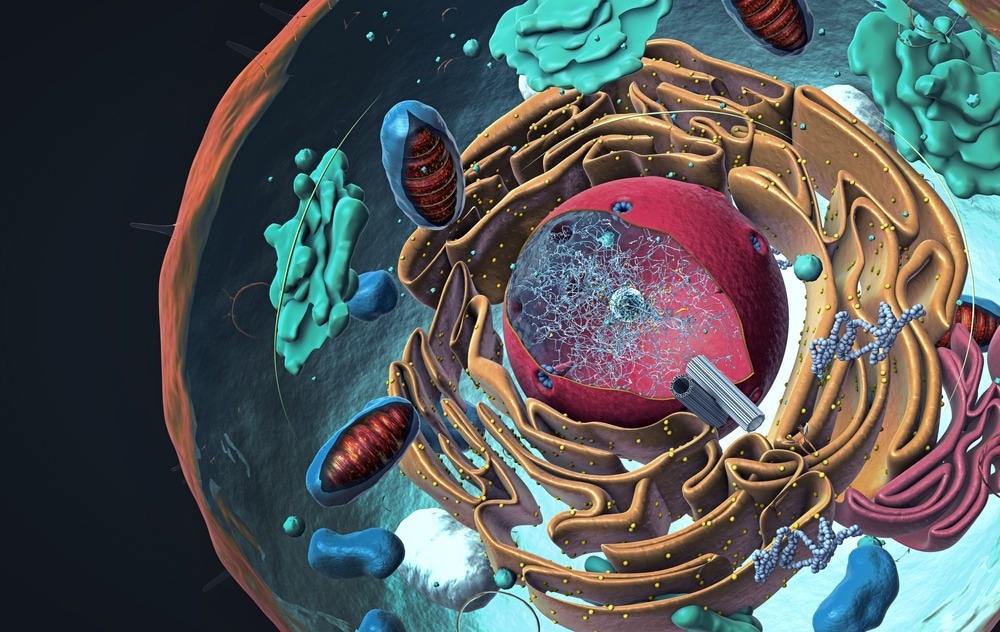Scientists have recently developed amine-terminated nanodiamonds (ND) by modifying carboxylic acid-functionalized nanodiamonds (ND-COOH) with poly(amidoamine) dendrimer (PAMAM). The newly designed ND exhibited a high potential as a candidate for drug delivery in cancer cells. This study is available as an accepted manuscript in ACS Applied Bio Materials.

Study: Dendrimer-Functionalized Nanodiamonds as Safe and Efficient Drug Carriers for Cancer Therapy: Nucleus Penetrating Nanoparticles. Image Credit: Christoph Burgstedt/Shutterstock.com
Nanodiamonds-A Potential Candidate for Cancer Treatment
Although scientists have developed many cargo materials to deliver active ingredients across specific cells, there is a quest for more stable and safer nanocarriers to improve drug delivery systems. Recently, NDs have been applied in various areas of biomedical research, including drug and gene delivery and bioimaging. This is because NDs possess a high surface-to-volume ratio, are non-cytotoxic, have surfaces that are easy to modify, have high biocompatibility, and are inclined to accumulate in tumor cells.
Previous studies have reported that biomolecules can be loaded into NDs both by the physical adsorption method and covalent grafting. NDs are used as nanocargo owing to their high surface area along with the presence of nanosized pores, which aids in their high payload through physical adsorption.
Utilizing unmodified NDs as nanocargo bears many challenges, including aqueous colloidal instability, as they are susceptible to forming aggregates with large agglutinate sizes. This drawback could be alleviated via surface modification of NDs with macromolecules and polymers.
PAMAM forms a stable interaction between the surfaces of the nanocarrier and a variety of bioactive compounds or payloads. Owing to the presence of amine groups (positively charged), a variety of payloads can move across cell membranes rapidly. Additionally, it also enhances the ND aqueous colloidal stability.
Previous studies have reported that fourth-generation PAMAM can evade ependyma and penetrate the central nervous system’s (CNS) dural surface owing to its unique nanotopographic symmetrical geometry. However, PAMAM dendrimers are not applied for in vivo applications due to their cytotoxicity.
Cabazitaxel for Treatment of Brain Tumor
The Food and Drug Administration (FDA) has approved the application of second-generation taxane, cabazitaxel (CTX), for the treatment of axane-resistant metastatic castration-resistant prostate cancer (mCRPC).
Studies have shown that CTX is a promising candidate for treating brain tumors. However, delivery of appropriate concentration of CTX to the brain is restricted because hydrophobic natured nanocarriers face obstruction while crossing the blood-brain barrier (BBB).
To overcome this problem of water solubility, commercially available CTX contains a high amount of cosolvent (e.g., polysorbate 80 and ethanol); however, these excipients cause neurotoxicity and hypersensitivity.
Effectiveness of ND-PAMAM-CTX for Cancer Treatment
In a new study, researchers have strategically designed and synthesized a nanocargo, i.e., CTX loaded on PAMAM-modified NDs (ND-PAMAM-CTX) in nanocrystalline form. ND-PAMAM-CTX has exhibited considerable improvement in cellular intake and has increased the drug's efficacy at a low dose.
In this study, researchers have used the ultrasound probe sonication homogenization method to load microcrystalline CTX on NP to form an ND-PAMAM-CTX nanoconjugate (NPC). Scientists reported that NP enables the encapsulation of weekly water-soluble CTX in nanocrystalline form, with enhanced loading capacity.
Researchers observed that a considerable decrease in the size of ND particles occurred with the increase in pH. This is due to the ionization of the carboxylic group on the surface, which inhibited aggregation due to electrostatic repulsions. The TEM image of crystalline ND-PAMAM-CTX revealed a rod-shaped morphology, whose size ranged between 130 and 200 nm.
Researchers used an UV−vis spectrophotometer to determine the amount of loading of CTX on an NP carrier. They reported the loading capacity to be 8.2 μg/mL, 11.0 μg/mL, and 6.4 μg/mL at pH 4, 6, and 7.4, respectively. Scientists reported that the cumulative release of CTX from NPC nanoconjugate was pH-dependent.
At acidic pH, the cumulative release of CTX from NPC was high because of the protonation of the PAMAM dendrimer cavity. This event influenced the conformational changes and weakening of bonds between dendrimer and drug. This is one of the most important characteristic features of the nanocarrier for cancer treatment because the release of the drug at an acidic condition is analogous to the pH level of a cancerous microenvironment.
Scientists also assessed the effect of NPC and crystalline CTX in the glioblastoma multiforme (GBM), one of the most aggressive forms of cancer that starts in the brain. They observed that the newly designed CTX drug-loaded nanoparticles swiftly penetrated the cells, primarily localized in the cytoplasm and colocalized in the nucleus.
The authors reported that the new nanocargo was not only able to cross deeper brain parenchyma sites but significantly inhibited the migration of cells at a low concentration of CTX on NPC nanoconjugate. Additionally, ND-PAMAM-CTX also elevated antimetastatic effect at low dosage.
The current study provides mechanistic insights into how ND-PAMAM-CTX interacts with cancer cells. Researchers stated that ND-PAMAM-CTX was responsible for supporting the suppression of tubulin depolymerization and reduction in tubulin proteins, which are important for cellular division. The authors believe that using ND-PAMAM-CTX could be an effective and safe treatment of brain tumors in the future.
Reference
Patil, S. et al. (2022) Dendrimer-Functionalized Nanodiamonds as Safe and Efficient Drug Carriers for Cancer Therapy: Nucleus Penetrating Nanoparticles. ACS Applied Bio Materials. https://pubs.acs.org/doi/10.1021/acsabm.2c00373.
Disclaimer: The views expressed here are those of the author expressed in their private capacity and do not necessarily represent the views of AZoM.com Limited T/A AZoNetwork the owner and operator of this website. This disclaimer forms part of the Terms and conditions of use of this website.